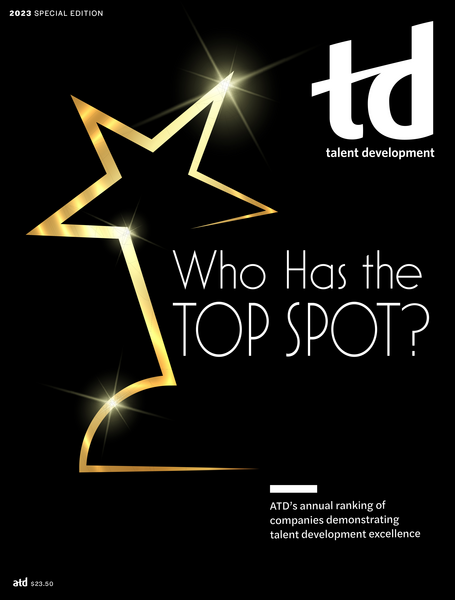TD Magazine Article
High-Tech Solutions for High-Tech Companies
Novel learning solutions meet rapidly changing training needs.
Thu Jun 15 2023

The BEST Awards recognize organizations that demonstrate enterprise-wide success as a result of employee talent development. The winners use learning as a strategic business tool to get results. View the entire list of 2023 BEST Award winners.
Novel learning solutions meet rapidly changing training needs.
Nowhere is the rapid pace of technological development more significant than in the IT and tech services sector, where TD teams constantly scan the environment to ensure their training programs—and employees—rise to the occasion.
"The landscape of talent is witnessing a tectonic shift. The challenge of a chronic shortage of skills has the potential to become a strategic bottleneck," says Kavita Kurup, global head of HR at UST in Aliso Viejo, California. "Investing in talent development and employee learning \[and\] skills is not just a necessity but also an opportunity for companies to empower their workforce and unleash their full potential."
In the IT industry, "people and their skills are vital to business success," says Prashant Nambiar, head of talent transformation at Wipro Limited, a Best of the BEST winner (earning a BEST Award 10-plus times) in Bangalore, India. Because the technology change cycle spins so quickly, customers—and customers' customers—expect more in products and services, he says, necessitating upgrades to talent development processes and employee upskilling.
TD innovations
One of recent innovative solutions at IBM, another Best of the BEST winner, involved the TD team expanding its AskHR chatbot program last year. "The AskHR team incorporated automation, AI \[artificial intelligence\] components, and continued training," explains Catherine Rickelman, senior talent solutions architect. By December, the bot handled "94 percent of company-wide HR-related queries," freeing up HR employees for other tasks.
For Best of the BEST winner Infosys Limited, its TD team elevated the hybrid training model by creating more interactive and efficient learning, according to Thirumala Arohi, who is responsible for the talent transformation platform at the Bangalore, India-based company. The talent platform is infused with AI-powered algorithms. "We leveraged our AI virtual assistant, Zoiee, to become a learning companion," he says. Zoiee recommends courses, helps learners understand concepts, and nudges them to complete the learning.
Arohi's team also debuted Playgrounds, a simulated lab environment wherein learners—both new hires and those upskilling—practice and test new skills. "We were able to certify the learners online—even in hands-on assessments," he states.
In addition, the team introduced Atlas, which provides a gamified learning path; Concept Graph, which acts as a mind map for learning; and Skill Role Framework, which provides a platform for learners to upskill or reskill and connects to their job role and career progression. "We introduced multiple tools to keep our learners engaged," Arohi notes.
Infosys even integrated heartbeat telemetry into its learning program. "Using telemetry to collect and analyze data allowed us to better understand how the organization is performing and identify areas for improvement," explains Arohi. The TD team studies patterns of learning—"the type of content that works best, days people learn more, which devices they prefer, which technologies are trending ... and how new content is faring"—then develops more targeted learning programs.
At Hitachi Vantara in Santa Clara, California, the TD function sensed a significant gap between opportunity and available talent last year and, as a result, collaborated to build a strategic business practice for the Internet of Things. "The curriculum focused on business and technical skills segmented into foundational and intermediate levels," explains Jay Erikson, global director of L&D. "The program produced trained employees, ready for billable engagements." Hitachi Vantara internally recognized the initiative as the Practice of the Year.
Advanced platforms
Advanced portals and platforms have helped to facilitate learning. For example, Hitachi Vantara has started leveraging a single-source platform for talent information, performance management, compensation, and people analytics. The L&D team uses the platform to view its talent globally, develop strong leaders, and position employees effectively.
In launching a career management portal last year, UST aimed for "mass personalization." The portal adapts an outcome-based approach toward career development, empowering associates to "own" their careers. "Capturing skills and career aspirations, personalized learning journeys facilitate the creation of a talent marketplace where everyone knows what skills and outcomes are required as well as available," explains Kurup. The portal delineates a career architecture "that expands ... and clarifies the role definitions in a purpose-centric manner."
Targeted training
L&D leaders at Hitachi Vantara rolled out several internal, targeted training programs such as design thinking and project management certification, which are examples of role-specific credentials employees must obtain to perform their roles successfully.
At IBM, the TD team strives to find ways to improve its compliance training to create a more consumable experience for its employees. "Our Cybersecurity/Data Privacy course is a great example of employing adaptive learning methods that permit the learner to move quickly through knowledge and skills they already have," says Rickelman. Participants self-pace through the content, "which many learners complete in 45 minutes because they demonstrate they know the concepts."
Upskilling opportunities
TD professionals at many IT companies offer upskilling programs to prepare employees for rapidly evolving opportunities. For example, UST's TD team designed "performance outcome-driven learning interventions tied to specific demands from the business," says Kurup. The system facilitates internal mobility and reduces time to embed recent graduates into the fabric of the organization. "We are now able to deploy 90 percent of our \[recent graduates\] to client engagements within 30 days of completion of their skilling interventions."
UST's Made to Order and Made to Stock frameworks equip more-tenured employees with skills to take on bigger roles with more accountability. "This has helped increase our internal fulfillment of roles from 37 percent to 57 percent, facilitating career growth for our employees and retention of our high-potential employees," says Kurup.
IBM employees can sharpen their skills via a digital badge program that helps practitioners gain technical skills and ultimately achieve widely accepted IBM credentials, according to Rickelman. That initiative is one example of "how we fill a specific skills gap, address industry needs, address upskilling demands, and offer just-in-time learning," she says.
Similarly, an initiative at Hitachi Vantara involved the TD team collaborating with executives, business leaders, and go-to-market teams on a future-of-work assessment. The extensive analysis "included interviews, focus groups, and external benchmarks. It identified the skills and attitudes to enable performance and support company culture," explains Erikson. The outcome of the assessment is a globally supported road map for future TD initiatives.
At Wipro, employees navigate through "work-integrated learning programs": a blend of in-house skills development and university-enabled higher education programs. "About 15,000 associates who belong to this talent development project have participated in various skilling programs, along with pursuing their higher education programs with one of the leading universities in India," explains Nambiar.
In addition, Wipro adopted a "hyperscaler model" to upskill employees in trending technologies—focusing on cloud, data, AI, and machine learning skills. "We focused on building enterprise-level competency in these areas," says Nambiar, to equip employees in a fast-paced environment demanding just-in-time capabilities. Via the focused learning model, 10,500 employees completed training and 4,100 earned certification. The initiative elevated Wipro's position in global rankings in various cloud technologies. "For example, the Google Cloud Certification has moved Wipro's ranking from 12th to seventh," says Nambiar. "In Azure cloud, we continue our position at number 1 in trained skills/learners and number 2 in certifications."

